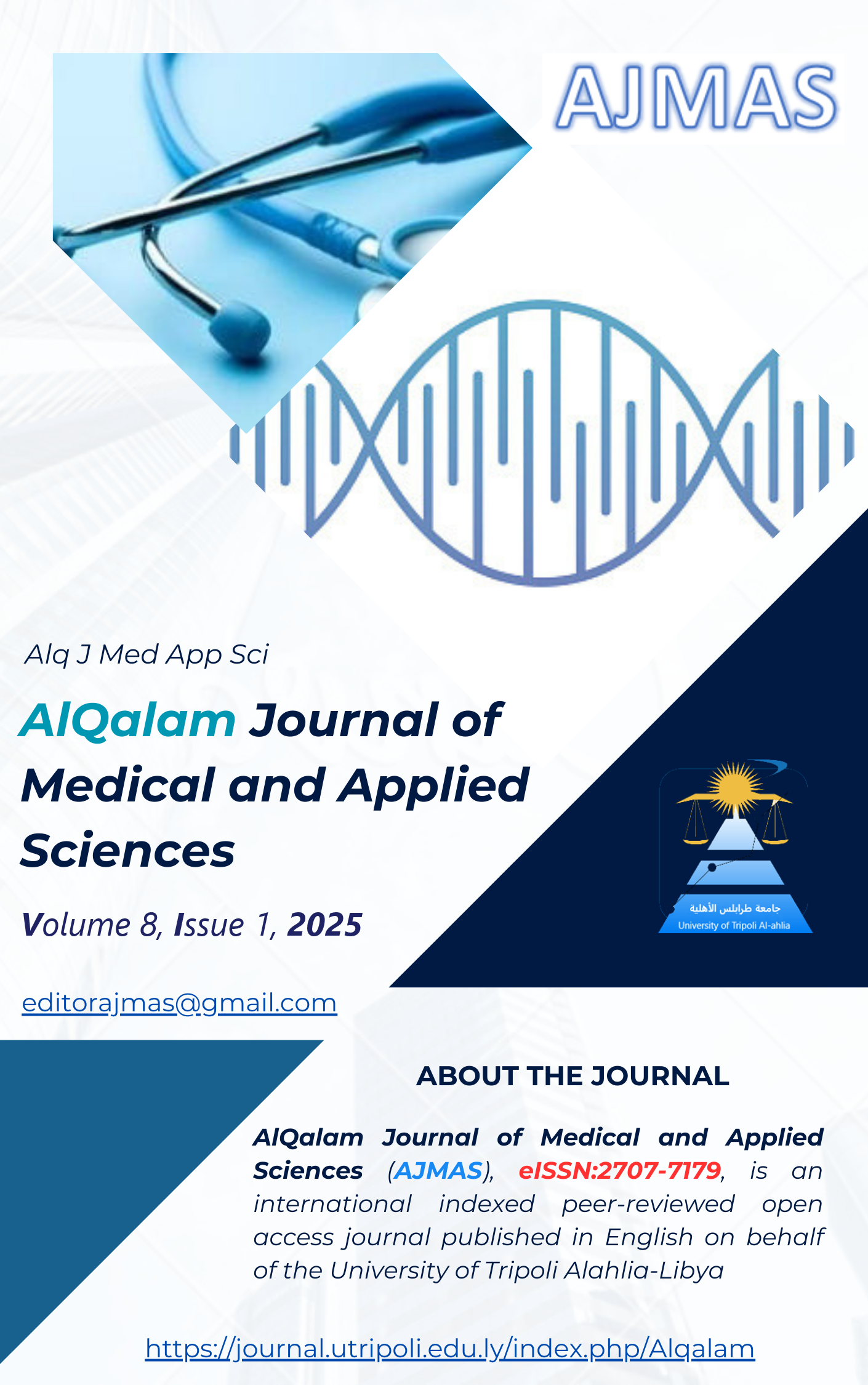In Vitro Evaluation of the Fracture Strength among Three Different Denture Base Materials
DOI:
https://doi.org/10.54361/ajmas.258135Keywords:
Fracture Strength, Denture Base Materials, LibyaAbstract
Failure in the form of denture fracture is commonly encountered by both removable prosthodontics wearers and dentists, it is mainly attributed to material properties, technical features, stresses while in function or due to impact as a consequence of dropping the dentures. Traditionally, Heat-Polymerized Polymethylmethacrylate (PMMA) has been the gold standard for denture bases due to its ease of processing and acceptable mechanical properties. However, newer materials, injectable flexible nylon-based resin and CAD/CAM Polyether ether Ketone (PEEK) denture bases are being introduced with claims of superior strength and durability. The aim of this study was to investigate the fracture strength of three commonly used denture base materials in Libya, which may aid in selecting the best material for a given application and predicting potential material behavior under load when holding the durability of the material in mind. A total of 36 samples were tested. These samples were divided into three groups, with 12 samples each: Group I heat polymerized acrylic resin PMMA, group II Injectable flexible nylon-based resin and group III CAD/CAM (PEEK). The fracture strength test was carried out on a universal testing machine at a crosshead speed of 5 mm/min. The results were analyzed using ANOVA, and multiple comparisons were undertaken using Tukey’s HSD test. Statistical significance was set at P ≤ 0.001. The result of this study shows there were significant differences in the fracture strength among the three groups (P< 0.001). Moreover, CAD/CAM (PEEK) denture base material exhibited significantly the highest fracture strength (234.17N ± 13.5) whereas the least fracture strength value was measured with Injectable flexible nylon-based resin denture base material (75.25N±10.5). The study concluded that, within the limitations of this study, the results demonstrate that CAD/CAM (PEEK) outperforms Injectable flexible nylon-based resin and heat polymerized acrylic denture base materials in terms of the fracture strength, supporting its potential as an advanced material for denture construction. However, further clinical studies are recommended.
يعتبر الفشل في شكل كسر طقم الأسنان المتحرك من الأمور الشائعة التي يواجهها كل من مرتدي أطقم الأسنان المتحركة وأطباء الأسنان، ويرجع ذلك بشكل أساسي إلى خصائص المواد والميزات التقنية والاجهاد أثناء الاستخدام أو بسبب استضام نتيجة سقوط طقم الأسنان. تقليديًا، كان بولي ميثيل ميثاكريلات المبلمر بالحرارة هو المعيار الذهبي لقواعد طقم الأسنان المتحرك نظرًا لسهولة معالجته و تشكيله و خواصه الميكانيكية المقبولة. ومع ذلك، يتم تقديم مواد أحدث، كراتنج مرن قابل للحقن قائم على النايلون ومادة متعدد ايثر ايثر كيتون كاد/كام المصممه و المصنعة بواسطة الكمبيوتر كقواعد أطقم الأسنان مع ادعاءات بالقوة والمتانة الفائقة. كان الهدف من هذه الدراسة هو التحقيق في قوة الكسر لثلاث مواد شائعة الاستخدام لقاعدة طقم الأسنان في ليبيا، والتي قد تساعد في اختيار أفضل مادة لتطبيق معين والتنبؤ بسلوك المادة المحتمل تحت الحمل مع وضع متانة المادة في الاعتبار. تم اختبار ما مجموعه 36 عينة. تم تقسيم هذه العينات إلى ثلاث مجموعات، كل منها 12 عينة: المجموعة الأولى راتنج الأكريليك المبلمر بالحرارة، المجموعة الثانية راتنج النايلون المرن القابل للحقن والمجموعة الثالثة متعدد ايثر ايثر كيتون كاد/كام المصممة و المصنعة بواسطة الكمبيوتر. تم إجراء اختبار قوة الكسر على آلة اختبار عالمية بسرعة رأس متقاطع 5 مم / دقيقة. تم تحليل النتائج باستخدام اختبار ANOVA و تم اجراء مقارنات باستخدام اختبار Tukey's HDS أظهرت نتائج هذه الدراسة وجود فروق ذات دلالة إحصائية في قوة الكسر بين مجموعات العينات عند .p<0.001 أظهرت النتائج ان قاعدة طقم الاسنان المصممة و المصنعة بواسطة الكمبيوتر اعلى قوة كسر (234.17N ± 13.5 ) بينما تم قياس اقل قيمة قوة كسر في الراتينج المرن القابل للحقن ( 75.25N ± 10.5) وخلصت الدراسة إلى أنه ضمن حدود هذه الدراسة، أظهرت النتائج أن مادة متعدد ايثر ايثر كيتون كاد /كام المصممه و المصنعة بواسطة الكمبيوتر تتفوق على وراتينج مرن قابل للحقن قائم على النايلون ومواد قاعدة الأكريليك المصنوعة من البوليمر الحراري من حيث قوة الكسر، مما يدعم إمكاناتها كمادة متقدمة لبناء أطقم الأسنان. ومع ذلك، يوصى بإجراء المزيد من الدراسات السريرية
Downloads
Published
How to Cite
Issue
Section
License
Copyright (c) 2025 Narjes Mohsen, Mohamed Elmaroush, Sarra Ben Hamida, Fatima Abusua

This work is licensed under a Creative Commons Attribution 4.0 International License.














